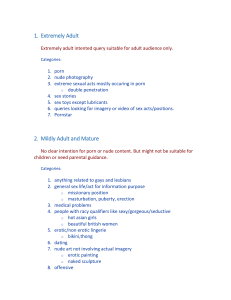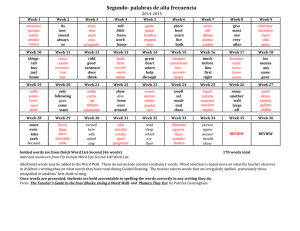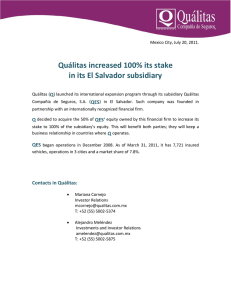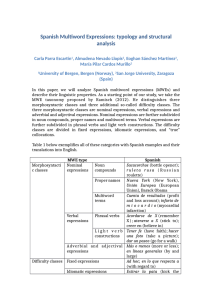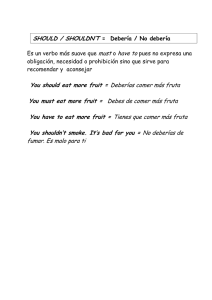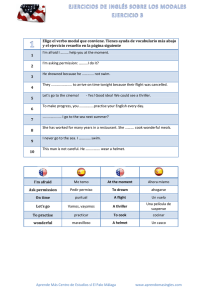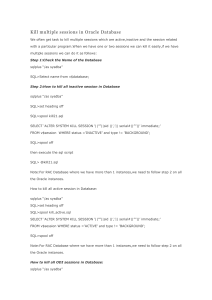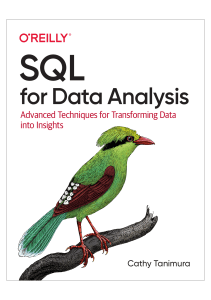Translation of Spanish Statistics Expressions to SQL
Anuncio
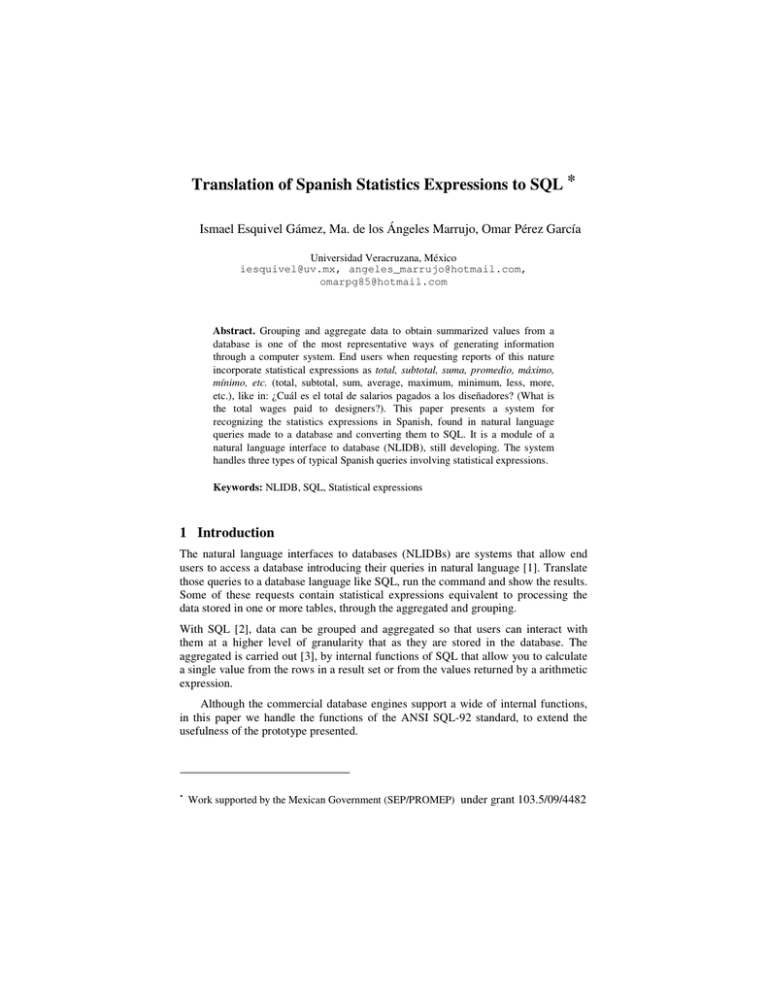
Translation of Spanish Statistics Expressions to SQL *
Ismael Esquivel Gámez, Ma. de los Ángeles Marrujo, Omar Pérez García
Universidad Veracruzana, México
iesquivel@uv.mx, angeles_marrujo@hotmail.com,
omarpg85@hotmail.com
Abstract. Grouping and aggregate data to obtain summarized values from a
database is one of the most representative ways of generating information
through a computer system. End users when requesting reports of this nature
incorporate statistical expressions as total, subtotal, suma, promedio, máximo,
mínimo, etc. (total, subtotal, sum, average, maximum, minimum, less, more,
etc.), like in: ¿Cuál es el total de salarios pagados a los diseñadores? (What is
the total wages paid to designers?). This paper presents a system for
recognizing the statistics expressions in Spanish, found in natural language
queries made to a database and converting them to SQL. It is a module of a
natural language interface to database (NLIDB), still developing. The system
handles three types of typical Spanish queries involving statistical expressions.
Keywords: NLIDB, SQL, Statistical expressions
1 Introduction
The natural language interfaces to databases (NLIDBs) are systems that allow end
users to access a database introducing their queries in natural language [1]. Translate
those queries to a database language like SQL, run the command and show the results.
Some of these requests contain statistical expressions equivalent to processing the
data stored in one or more tables, through the aggregated and grouping.
With SQL [2], data can be grouped and aggregated so that users can interact with
them at a higher level of granularity that as they are stored in the database. The
aggregated is carried out [3], by internal functions of SQL that allow you to calculate
a single value from the rows in a result set or from the values returned by a arithmetic
expression.
Although the commercial database engines support a wide of internal functions,
in this paper we handle the functions of the ANSI SQL-92 standard, to extend the
usefulness of the prototype presented.
*
Work supported by the Mexican Government (SEP/PROMEP) under grant 103.5/09/4482
In a natural language query may appear multiple statistical expressions, creating
some degree of complexity in its conversion. In this report, we describe a module of a
Spanish NLIDB, named SNL2SQL, under construction. Converts the query issued by
an end user, containing statistical expressions, to the corresponding SQL SELECT
command.
2 Related work
According to the classification of queries in [4], consisting of six types, this paper
focuses on solving the query type that requires special functions (number 5). For this
reason, works in Spanish and English that translate this type to SQL, were reviewed.
In [5] handles a module, which translates from Spanish to an SQL query through
four steps. In each, the query is subjected to several transformations by: The
generation of an equivalent template semantic, the adaptation of the template data to
those found in the database, the generation of the complete and final template and
finally, the formulation of the corresponding SQL statement. In their work, the use of
internal and external functions, it was proposed. For the first ones: Unidades,
diferencia_fecha, superlativo, cuenta y promedio (Units, date difference, superlative,
average and count), of which only the last three were translated directly into SQL
aggregate functions and the other required a pre-conditioning.
To improve the process of setting up their NLIDB [6], they propose ontology to
achieve greater acceptance and therefore, accessibility. The ontology defines
categories to organize the concepts that have the context of the database. Among the
highest hierarchy, were defined: Database elements, words, sets of synonyms
(synsets) and functions. The latter were classified in: SQL Functions, User defined
and call-link. For the former, groups of words or synsets, were equivalent to
aggregate functions, semantically speaking.
In their methodology [7], they used natural language generation (NLG) as an
alternative to remove the interpretation stage of queries. Those are constructed by the
user through successive interactions with a natural language text, called feedback text.
Changes to it are reflected in the semantic content of the query and are made in parts
of the text enclosed by [], named anchors. In these, values can be changed, add
aggregate functions, change or remove filters and order conditions; to generate the
corresponding SELECT statement.
In their case [8] designed a graphical user interface and a grammar-driven phrases,
like natural language grammar, called PDG. To enter a query and displaying the
results, it follows a process of constructing sentences, targeted for users with no
experience in data access and visualization. PDG manages aggregate functions with
operators such as “number of”, “sum of”, and “avg of”; and whose argument is
specified by [data], which can be used with "For Each data" phrase. The lowest and
larger operators are used to obtain minimum and maximum. It also handles grouping
facilities to generate queries shorter and clearer than SQL.
3
Proposed approach
As part of the implementation and after analyzing the corpus of queries made to the
test database by students and faculty from IT area, three types of questions associated
with statistical expressions were found. Table 1 shows the types that this proposal
addresses and the SELECT commands associated.
Table 1. Types of queries and associated commands
Type
Query
SELECT command
1
¿Cuál es el total de salarios?
(What is the total wages?)
Select sum(Empl.salary)
From Empl
2
¿Cuántos empleados se tienen por
cada departamento?
(How many employees have every
department?)
Select Empl.Workdept, count(*)
From Empl
Group by 1
Order by 2 Desc
3
¿Quién gana más salario de los
empleados?
(Who earns more salary for
employees?)
Select Empl.Empno, Sum(Empl.salary)
From Empl
Group by 1
Order by 2 Desc
Although the third type can be solved with a subquery, we have found advantages
with the approach proposed, among some, the orderly deployment of multiple
records, allowing a more comfortable view of the information collected.
Likewise, were detected most common statistical expressions found in queries in
Spanish, which are partially showed in Table 2. After a comprehensive analysis of
questions and expressions, it was found that some of them created uncertainty, about
the type of question that was being dealt (1 or 3), being regularly the following: más,
mayor, menos, menor (more, higher, less, smallest), named special terms.
3.1 Assumptions and limitations
For the database, we used the assumptions that were proposed in [9], from C1 to C15
and for the queries made by the end user (A1 and A2), adding the management of
mandatory queries (“Displays the maximum salary”).
Managing expressions as an argument to a function is limited to those explicitly
handle the attributes and processing, for example “El total del salario menos la
commission” (The total salary minus the commission)
This first prototype does not handle the filtering of groups with the HAVING
clause of the SELECT or relationship between tables (JOIN).
3.2 Previous configuration
Before using the module, the administrator needs to do certain tasks, among which
are:
3.2.1 Registration of domain values
For attributes that handle a set of valid values that can take (domains), mainly for
those with short values, for example SEX (‘F’, ‘M’), is necessary to capture the
synonyms for these values: ‘MUJERES’, ’FÉMINAS’, ’FEMENINO’, ’HOMBRES’,
’VARONES’, ’MASCULINO’, etc. ('WOMEN', 'FEMINIST', 'FEMALE', 'MALE',
'MALE', 'MALE', etc.), in a file called Content Dictionary. It serves to facilitate
processing, primarily the WHERE clause and thus, it encourages the use of terms,
characteristic of the enterprise environment, where the prototype is implemented.
Table 2. Statistical Expression and aggregate functions
Expressions
Data type
SQL Function
Total, suma, sumatoria,
subtotal, …
(Total, sum, sum, subtotal…)
Numeric
SUM([DISTINCT] X)
Promedio, media, …
(Average, average,…)
Numeric
AVG([DISTINCT] X)
Menos, menor, mínimo, más
(reciente),
…,
(Less, smallest, minimum,
Most (recent)…,)
All
MIN([DISTINCT] X)
Más, mayor, máximo,
menos (viejo),
…,
(More, higher, maximum,
Less (older), …, )
All
MAX([DISTINCT] X)
Cuántos, cantidad, número de,
cuenta de,…,
Values
COUNT([DISTINCT] X)
Tuples
COUNT(*)
(How many, quantity, number
of…, count of…,)
Cuántos, cantidad, número de,
cuenta de,…,
(How many, quantity, number
of…, count of…,)
3.2.2 Definition of grouping attributes
It is required to select the attributes that are grouped in a dictionary. Also a series of
queries of the database can be run for purposes of automating the operation. For each
attribute, is issued a command like this:
Select <table.attribute>, count(*) from <table> group by 1 having count(*) > 1
3.2.3 Election of the attribute to use by default
It is necessary to define for each table, a unique attribute that fully describe each tuple
and that this is enough descriptive, like in [10], when the query does not express the
grouping attribute, for example ¿Quién gana más salario? (Who earns more salary?).
For the present case, were chosen: Employee Number (Empl.Empno), department
name (Dept.Deptname), project name (Project.Projname).
The last two definitions are stored in the domain dictionary, which is described
below.
The prototype uses two dictionaries, the main also called "domain" and the
secondary, called "content." The first was built from a synonym dictionary and the
database metadata, based on the paper of Pazos et. al [8]. From the metadata is
extracted by each table: name, description, and details of their columns (name, data
type, size, permissibility of null values and its description. From the processing of the
latter, are obtained nouns and partnership to the columns and tables, that in its
description containing them or their synonyms. Also is obtained the equations
representing the links between the tables to process queries with join. The dictionary
content is updated similarly for columns that handle sets of valid values.
For this work, the synonym dictionary has been built manually using the online
dictionary provided in [11], but the idea is to generate it automatically, in the future.
4
Main algorithm
The translation process is carried out following the next steps:
For all three types of questions:
1.
Statistical expressions are identified in the question in any of the following
cases:
a. There are one or more and do not correspond to the special terms, in
which case proceed to Step 2. For example the queries “¿Cuál es el
monto total de salarios para diseñadores y operadores?” (What is
the total amount of salaries for designers and operators? or “¿Cuál
2.
3.
4.
es el salario máximo y salario mínimo de los gerentes?” (What is
the maximum wage and minimum wage for managers?).
b. There are two or more and one of them is special term like in
“¿Qué departamento tiene el promedio de salarios más alto?”
(What department has the highest average salary?), in which case,
the expression is ignored momentarily and move on to step 2
c. There is one and belongs to such terms, for which we continue to
step 8. For example, “¿Qué mujeres ganan más salario?” (What
women earn more salary?).
Found expressions define aggregate functions to use according the Table 1,
eliminating such expressions of the query.
Determine the argument of the function, from the processing of words
associated with the statistical expression, arranged in one of the following
cases:
a. Next, before or after, like in “Salario mínimo” (minimum wage).
b. Connected with the preposition “de” (of) or “de” (of) and an article.
Examples: “Total de bonos” (Total of bonus), “promedio de la
commission” (Average of the commission).
c. As a noun attached to “Cuántos” (How many), for example:
“¿Cuántos empleados…?” (How many employees…?).
d. As an arithmetic expression, denoted by the use of preposition
(“of”) and conjunction (“and”), as resolved in [9]. An expression
like “El total de salarios y comisión” (Total of wages and
commission).
e. Connected to words that involve the processing of non-repeated
values, for example “Únicos”, “distintos”, “diferentes” (Unique,
different, etc.), in which case the term DISTINCT is added to the
argument as a prefix.
Then it searches the domain dictionary to determine the pair table-attribute
that will serve as an argument. The question is marked as “invalid” when it is
not found or when the attribute handle a data type incompatible with the
function. When there is more than one pair, the query is marked as
“ambiguous”. In the case of the COUNT function, the argument is the
symbol (*), when asked the number of rows, therefore only needs to
extracted from the question the name of the table to process, like in
“¿Cuántos trabajadores son varones?” (How many workers are male?).
Nouns for the argument of the function and eventually, the terms of
distinction, are removed from the question.
Question type 2:
5. All expressions involving grouping are identified, for example “Por”, “por
cada”, “en cada”, “en”, etc. (By, for every, every, in, etc.), in the order they
appear in the question.
6. Nouns associated with the previous expressions, are sought in the domain
dictionary entries, only for those attributes previously marked as grouped, to
determine the column(s) to use in the grouping clause. If not found, the
question is marked as “invalid” and if there is more than one, as
“ambiguous” Then both, nouns and expressions associated, are removed
from the question.
7. Add the “order by” clause, indicating the numbers of columns that functions
occupy in the SELECT clause with the DESCENDING option, to show
higher figures, first.
Question type 3:
8. Given that there has not been defined the aggregate function, nouns
associated with the special terms: más, mayor, menos, menor (more, higher,
less, smallest) are processed as in step 3, to get the argument of the function,
which will be one of the following:
a. If the data type is numeric, SUM(X)
b. If it is date or date and time, MIN(X)
9. It is determined the column(s) used (s) in the grouping clause, searching for
the remaining nouns in the dictionary domain. If not found, for example:
¿Quién gana más salario de los empleados? (Who earns more salary for
employees?), the default defined column, described previously, is used. Then
the “order by” clause is added, indicating the number of the column that the
function occupies in the select clause, adding the Ascending or Descending
option, according to the special term yet found in the text of the question. So
Ascending option is associated with terms such as menos, menor (less,
smallest), and DESCENDING with más, mayor (more, highest). However,
there are nouns like old and antique, in which case, result in reverse.
Finally, for the three types:
10. Expressions of filtering results are processed, to build the WHERE clause,
then removing those expressions.
5
Experimental Results
The test database used is shown in Figure 1. The corpus of natural language queries
was formed after the presentation of the Database and explanation of the project to
teachers and students of the IT area. They were asked to write queries of the three
types,
s, and 27, 17 and 21, respectively were obtained, after eliminating similar.
From the corpus generated, which consisted of 65 requests, the results obtained are
shown in Table 3. The conversion process took questions from a file and marked the
non-translated queries
eries with an “I” for invalid, “A” for ambiguous, and “X” for
incorrect.
Fig. 1. Logical diagram of the test database.
It wass found that all the "invalid
"invalid" queries, contained terms that could serve as
function argument, but not explicitly indicated attributes and processing. For
example: “¿Cuál es la edad promedio de los gerentes?” (What
What is the average age of
managers?), “¿Cuál ha sido la duración promedio de los proyectos?” (What
What was the
average duration of projects?).
projects?). The "Incorrect" were those that contained no
statistical expression, like in “¿Cuál es el bono anual que reciben loss diseñadores?”
(What
What is the annual bonus received by designers?)
designers?
In general, the results were quite promising for being a first approximation, and
the support for implicit arithmetic expressions, undoubtedly will improve the
effectiveness. It is important
ortant to note that verification of the translation was done
manually, because no connection has yet implemented with a commercial database
engine.
Query type
Queries Formulated
Table 3. Results obtained
1
2
27
17
3
21
Total
65
“Invalid”
“Incorrect””
“Ambiguous
Ambiguous”
3
2
0
1
3
0
2
4
0
6
9
0
Translated
22
13
15
50
Effectiveness
81.48%
76.47%
71.43%
76.46%
The programming language used for development was Rexx (REstructured
eXtended eXecutor), a programming language developed at IBM by Michael
Cowlishaw, of which there are numerous open source implementations available [12].
Version 3.4 of the Regina Rexx interpreter for Windows was used and was chosen
because it has a wide set of functions, especially for the treatment of texts and dates.
Another crucial advantage to use Rexx is that it is a multiplatform language. It can,
with slight modifications, run on any computer under any operating system and work.
5
Conclusions
The module presents a very specific approach to treat statistical expressions that are
translated into SQL functions, grouping and order clauses. It is contemplated to test it
with real-applications databases containing a larger number of attributes of grouping
and aggregated.
The structure of queries from the corpus formed has been analyzed and found three
types that predominate in reporting requirements. Such questions are representative of
the reports requested by the executives and middle management, and therefore,
automatically translating is a key factor in development of the SNL2SQL NLIDB.
However, improvements are needed. One of the areas to improve is carry out the
translation of more complex queries containing expressions of group filtering and the
relationship between two or more tables. Another of the improvements is the
automation of both, the generation of the Dictionary of Synonyms and the verification
of the conversion.
There were several queries that were related to variables not considered in the
database, but with a more refined processing, can be obtained. It is possible to enrich
the tasks of the previous configuration and allow the entry of these variables, the
associated database attributes, system variables and arithmetic operations. For that
reason, the development of an enhanced version, to improve effectiveness, is a
priority line of work.
References
1.
Androutsopoulos, I., Ritchie, G., Thanisch, P.: Natural language interfaces
to databases - An introduction. Journal of Language Engineering, 1(1):2981, 1995.
2. Beaulieu, A.: Learning SQL, Second Edition, O’Reilly Media, Sebastopol
(2009).
3. Viescas, J. L., Hernandez M. J.: SQL Queries for Mere Mortals: A HandsOn Guide to Data Manipulation in SQL, Second Edition. Pearson
Education, Massachusetts (2008).
4. González J., Pazos, R. A., Gelbukh, A., Sidorov, G., Fraire, H., Cruz, C.:
Prepositions and conjunctions in a natural language interfaces to databases.
In: Thulasiraman, P., et al. (eds.) ISPA 2007 Workshops. LNCS Vol.
4723, pp. 173-182, Springer, Heidelberg (2007)
5. Colás, J.: Estrategias de incorporación de conocimiento sintáctico y
semántico en sistemas de comprensión del habla continua en español.
Estudios de lingüística española (ELIEs). Publicación periódica de
monografías
sobre
lingüística
española
(2001),
http://elies.rediris.es/elies12/index.html
6. Zarate, J. M., Pazos, R. A., Gelbukh, A., Pérez J.: Improving the
customization of natural language interface to databases using an ontology.
In: Gervasi, O, Gavrilova, M. (eds.) ICCSA 2007. LNCS Vol. 4705, Part.
I, PP. 424-435, 2007.
7. Hallett, C., Hardcastle, D.: Towards a bootstrapping NLIDB system. In:
Kapetanios, E., Sugumaran, M. Spiliopoulou (eds.) NLDB 2008. LNCS,
Vol. 5039, pp. 199-204, Springer, Heidelberg (2008)
8. Lee, S. Y., Neumann, U.: A Phrase-Driven Grammar System for
Interactive Data Visualization. In: Börner, K., Gröhn, M., Park, J., Roberts
J. C. (eds.) Visualization and Data Analysis 2008. SPIE Int. Soc. Opt. Eng.
Vol. 6829 (2008).
9. Pazos R., Pérez J., González J. J., Gelbukh A., Sidorov G. y Rodríguez
M. 2005. “A Domain Independent Natural Language Interface to
Databases Capable of Processing Complex Queries”. MICAI 2005:
Advances in Artificial Intelligence. MICAI 2005: 833-842
10. Stratica, N., Kosseim, L., Desai, B. C.: Using semantic templates for a
natural language interface to the CINDI virtual library, Data & Knowledge
Engineering,
v.55
n.1,
pp.
4-19,
October
2005
doi:
10.1016/j.datak.2004.12.002
11. Rodríguez S. y Carretero J. 2008. COES: Herramientas para
Procesamiento de Lenguaje Natural en Español.
http://www.datsi.fi.upm.es/~coes/interactivo/sinonimos.cgi
12. Mertz David. 2004. Rexx for everyone: Scripting with Free Software Rexx
implementations. http://www.ibm.com/developerworks/library/l-rexx.html
